- Visit
Admissions
Planning to visit us? Well then great because we have been waiting for you to come join us. Beerburrum Wildlife Center will always be a place in which you can have fun with family, friends, and peers without worrying.
Admission parking is free to all visitors at the Center’s parking lot and members are able to park in the reserved areas of the Center. If you plan on staying overnight you can enjoy yourself to our very own botanical rooms or you can choose from a list of close hotels.
You can buy tickets at the admissions window or if you wish for a speedy entrance then buy it online and come and go. The Center will be open until 8 pm on the weekdays and 10 pm on the weekends.

Important Information:
- Parking is free. Parking spaces are reserved for people with disabilities.
- ATMs are available outside near the admissions gate and inside Joey’s Shopping Cart.
- Items such as skateboards, firearms, glass, frisbee and anything related are not allowed. Pets are not allowed unless it is a service animal.
- Smoking is prohibited inside the zoo. If you wish to smoke please step out as it is hazardous to animals. Drugs and alcoholic beverages are prohibited.
Memberships
Become a member and help support us create a comfortable conservation center for animals.
Adult Senior Household(6 max) Household(7+) $55 $45 $80 $100 Benefits:
- Members receive discount for purchases of tickets and gifts.
- Updates and previews on zoo attractions and events included with a Beerburrum Wildlife Magazine.
- Free access to campus and programs.
Directions
1 Beerburrum Road
Beerburrum QLD 2222, Australia
33 4444
Beerburrum Wildlife Center is located in the Glass House Mountains National Park which is 68 km north of central Brisbane. Take the M1 Bruce Highway and then enter at Steve Irwin Way. Keep driving and then turn into Beerburrum Road and you will be there! If you are lost contact us and we will help you get here.
Open Seven Days a Week
Beerburrum Wildlife Center has something for everyone all year round. At no time during the year is more than 10 percent of the wildlife center closed to the public. We warmly invite you and your family to join us and experience the wonder that the Beerburrum Wildlife Center has to offer.
Weekday Schedule
Monday Tuesday Wednesday Thursday Friday Saturday Sunday 8:00 a.m to
8:00 p.m.10:00 a.m to
8:00 p.m.8:00 a.m to
8:00 p.m.10:00 a.m to
8:00 p.m.10:00 a.m to
8:00 p.m.7:00 a.m to
10:00 p.m.7:00 a.m to
10:00 p.m.Limited Access Dates
December 20 through December 24 - Island Sector Closed
January 12 through January 20 - Wetland, River, & Lake Sector Closed
February 10 through February 17 - Tundra Sector Closed
March 1 through March 4 - Coastline & Ocean Sector Closed
March 17 through March 21 - Scrubland Sector Closed
Beerburrum Wildlife Center
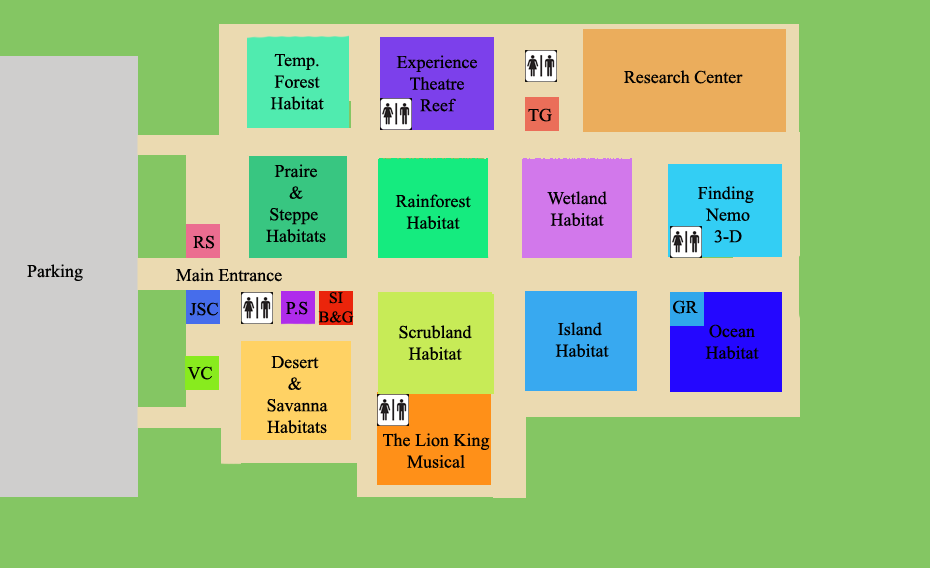
- Habitats
Coastline & Ocean
The coastline is the area where the land meets the sea or ocean. The ocean is the body of saline water that compose large part of the planet’s hydrosphere. Both are relevant to each other and always come together.
The coastline comes in many forms depending on the changes of the ocean’s tides. The ocean is very vast and is separated into different oceans and several seas. Yet despite this they will always the World Ocean, a single, gigantic body of water. Read more...
Desert
A desert is a landscape or region that receives extremely low amount of precipitation, causing it to be mainly without plant life. The habitat has only little enough precipitation to have few plants and bodies of water such as oasis.
Deserts take up one third of Earth’s land surface and have a diurnal and seasonal temperature. This means that the desert is hot during the day and cool during the night. Many of deserts are formed by rain shadows and may sometime contain valuable minerals. Read more...
Island
An island is any piece of sub-continental land surrounded by water. Islands can come in small shapes too and are sometimes surrounded by rivers or lake.
There are two types of islands the first being continental islands which lie on the continental shelf of continents. The second type is the oceanic continental island type that does not lie on the continental shelves. Read more...
Prairie & Steppe
Prairies are ecosystems considered part of the grasslands, shrublands and savannas by ecologists due to the similar climates and vegetation of the habitat. A steppe is an ecoregion in the shrublands, grasslands, and savannas without trees with the exception of those near lakes.
There are three types of prairie and these types are generally characterized by tallgrass prairie, mixed, or shortgrass prairie depending on the soil and rainfall. Despite harsh rains, prairies are resilient against soil erosion making great farmland. Read more...
Savanna
A savanna is a grassland ecosystem known by the trees being sufficiently small or widely spaced for room. The room gives it sufficient light to energize the grasses. There have been mention of savannas without trees as well.
The open land of the savanna gives livestock the opportunity to feed abundantly. Removal of the grass also helps by boosting tree growth and reduces fire. Grazing also promotes the spread of weeds in savannas by the removal or reduction of the plants. Read more...
Scrubland
The shrubland, scrubland or shrub is a plant community that has vegetation mainly of shrubs but will sometimes have grass or herbs and such. A shrubland is sometimes naturally made or even man-made but is not a favorable habitat for people.
Shrublands consist of short trees or shrubs and and is used to describe a biome plant group. Many shrubs thrive on steep, rocky slopes and are open enough for other vegetation to grow. In order to combat droughts the shrubs have also adapted to conserve water. Read more...
Temperate Forest & Taiga
Temperate rainforest are broadleaf forests that occur in the temperate zone and receive high rainfall. These habitats usually have an annual precipitation of 1400m.
Big coniferous trees mainly inhabit this place along with a few deciduous trees in the warmer spots of the rainforest. Other vegetations include mosses and lichens that help moisturize the rainforest giving it good soil as well. Read more...
Tropical Rain Forest
A tropical rainforest is an ecosystem that is within the latitudes 28 degrees north or south of the equator and experiences high average temperatures and a significant amount of rainfall. These rainforest are very warm and wet influencing the precipitation to cause poor soil.
Tropical rainforests have a wide range of biodiversity with a large number being indigenous to the rainforest. Rainforests are home to half of all the living animal and plant species on the planet. Two-thirds of all flowering plants can be found in rainforests. Read more...
Wetland, River, & Lake
A wetland is a land that has permanent or annual body of water that has a unique vegetation. The habitat has hydric soil, which supports the aquatic plants. Wetlands usually are to be used as water purification, flood control, and shoreline stability.
A river is a natural watercourse that flows toward another body of water or sometimes just flow into the ground or dry up. Smaller rivers may be called stream, creeks, or a couple other names, however they are all the same and still have the same function. Read more...
- Animals
- Science & Education
Science & Education
Research Centers
The research centers of Beerburrum Wildlife Center has always had one big goal and that one goal is the conservation of wildlife. Read more...
Teacher Resources
Teachers who wish to make their trip to the zoo a learning experience can contact us and set up an appointment. Read more...
School Programs
Helping students be aware with the wildlife and the animals so that they can be more careful with how they live. Read more...
Internship Program
College students all around the world can get a great experience as an intern at Beerburrum Wildlife Center. Read more...
Beerburrum Aquatic Research Institute
Arboreal Herbivorous Marsupial
- Get Involved
Mission Statement
The Beerburrum Wildlife Center’s greatest goal has always been to provide a place that will both educate and aid in the forms of protecting and helping wildlife. We want to make a place that will help creatures internationally and in doing so will help people understand the value of animals and environment conservation.
Volunteer at the Zoo
Volunteer, join, help and share your experience about the zoo so that others can get an opportunity to learn about the wildlife. Read more...
Make a Donation
Making a donation of any kind is the simplest and the most helpful support for the zoo. Donate to the zoo so that we can do our task of helping the animals.
Read more...Adopt a Habitat
Adopt a Habitat is a special program in which you can choose the habitat of the animal you want to help. The catch is that you will not just be helping your animal but the animals in the same habitat as well. Read more...
Corporate Sponsorship
If you wish to become a sponsor of a place that works to make environments and the livings of animals better this here is the spot. Read more...
- Events
Upcoming Events
Every year we have a number of events that we strive to accomplish safely and joyously. Some of these upcoming annual events are of the most spectacular events we hold once every year. Events like these should not be missed because if you do you will have to wait for next year to see it again. So come on down and enjoy a wonderful show.
Each event is a great show but there will be events that are so special that they will be given special privileges. Special events such as the New Years Late Night will have the zoo close later and will give zoo goers to experience New Years at a zoo.
Tickets for events will be available online and at the zoo. Tickets for the events will be sold separately from admission tickets. If you have a question concerning upcoming events please contact us.
Fall 2012
Event Name Event Description Opening Night Opening night will celebrate the opening of the zoo and feature guest performances by such stars as Hugh Jackman, Elton John, and others. Santa Claws Come meet Santa Claws, the Santa of the animal kingdom. Book Club Join members in the most recent discussion of books concerning animals. Annual Events
If you are interested in what kind of events we host annually then look no further. These are the events that occur once every year that people may come to attend. Some of these events are so exceptional it will occur even past our usual closing ours.
Our events are held at the same time every year and we make is so that is easy and ready to attend. So plan for the events and if you are a member you can get an early spot for these occasions.
Beerburrum Wildlife Center Traditions
Event Name Event Description Finding Moby Dick Be the first to finish the search for Moby Dick in this fun “The Amazing Race” based game. Dolphin Performance of the Year Watch the performance by the dolphins of Beerburrum Wildlife Center which people have called “absolutely great!” The New Years Late Night Spend the night preparing for the New Years countdown at the zoo. Santa Claws Come meet Santa Claws, the Santa of the animal kingdom. All Hallow’s Eve Night Prepare to be scared in one of the most frightening place in Queensland. Book Club Join members in the most recent discussion of books concerning animals. 
Weddings at Beerburrum
Weddings come and go and a wedding is always best when its setting and mood is perfect. So why not have a wedding here at Beerburrum Wildlife Center. Here we can give you wonderful scenery and place just as exotic as any other.
Marriage is truly a sight to behold and it is obvious that something like this should not be ruined by us who will be hosting your wedding. Planning to have your wedding at a zoo takes extra care and expert handling. An occasion like this is not something we overlook or handle without care. We will take extreme measures so that we will make this day as meaningful to you as it means to us.
If you wish to plan a wedding contact us and we will inform you right away.
Private Parties at Beerburrum
Planning on having a birthday party or just a party in general? Have it here at Beerburrum Wildlife Center where we will make you and your party go as smoothly as possible. You can enjoy a wide variety of animals and shows all the while spending time with all your friends.
If you plan on having a party on special event dates then you are in luck because a party is already on its way all you have to do is just prepare for the occasion.
If you wish to plan a party please contact us and we will inform you right away.


Corporate Events at Beerburrum
If there are annual events then where are the daily events of the zoo. These events are supported by our sponsors and help host shows that inform people of what we do and how thankful we are all of the help we have received.
Many of our staff and board members will be there to talk about how they got to where they are now because of such help.
Come and join us if you are interested please contact us or visit us.
- Food & Entertainment
Food & Entertainment at Beerburrum Wildlife Center
Shows
Enjoy a family and fun experience in our 15 meter wide HD screening of the many enjoyable adventures of the wild and the sea. If that isn’t enough then enjoy our theater where kids can watch our version of the Lion King Musical. Read more...
Restaurants
Satisfy your hunger at our food court where we provide a selection of food that you can choose from ranging from Tropic Grill’s burgers to Sweet Island’s sundaes. Read more...
Shopping
After a long day of fun and joy you can buy something from our shops so as to remember about this trip to Beerburrum Wildlife Center. Read more...
- Contact
Contact Us !
We warmly welcome you to join us here at the Beerburrum Wildlife Center. Should you have any questions, please do not hesitate to contact us via the contact form below.
Beerburrum Wildlife Center
Come join the excitement and experience the thrill of interacting with exotic animals. While you are visiting, we encourage you to partake in the scheduled entertainment events and taste the wonderful local cuisine. Should you need further assistance with regards to your planned wildlife center visit, please do not hesitate to contact us!
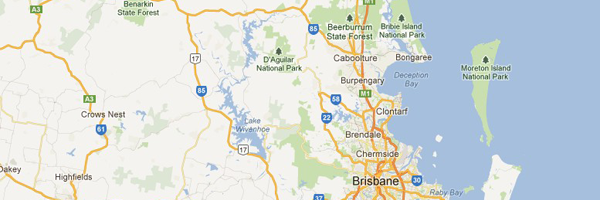
Come join us, and create memories that will last a lifetime!

Bird
Spinifex Pigeon
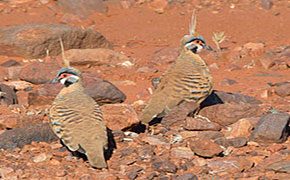
The Spinifex Pigeon (Geophaps plumifera) is a bird found in Australia. They are generally found in stony areas with low woodlands. They are a nomadic and terrestrial species.
There are two races of this species and the only difference between them is that they are both geologically separated and one is white-bellied while the other is red-bellied. Their flight is low and fast, often flipping and gliding in the flight and will breed during the spring, summer, or after the rain.
Wedged-Tailed Eagle

The Wedged-Tailed Eagle (Aquila audax), sometimes known as the Eaglehawk, is the largest bird of prey of Australia and the world, and is also found in Tasmania and New Guinea. They inhabit almost all habitats and are highly aerial, soaring for hours at very high heights, but it is unclear why they fly so high.
The females are bigger the the males and Adult females tend to be slightly paler than males. Although it rarely needs to be distinguished from other Aquila eagles, its long, wedge-shaped tail is unique to this species.
Black-Necked Stork
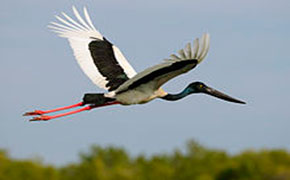
The Black-Necked Stork (Ephippiorhynchus asiaticus) is a tall long-necked wading bird found across South and Southeast Asia and having a large population in Australia. It lives in the wetlands to forage for prey and is very territorial when feeding. Both sexes look similar except the different iris color.
This large stork has a rather peculiar display in dancing. The pair stalk up to each other face to face, extending their wings and fluttering the wing tips rapidly and advancing their heads until the meet. They then clatter their bills and walk away. The stork is a carnivore and they are largely non-social and are usually seen as single birds, pairs and family groups.
Emu

The Emu (Dromaius novaehollandiae) is the largest bird native to Australia and is the second-largest extant bird in the world by height after the ostrich. The Emu is common over most of mainland Australia, although it avoids heavily populated areas, dense forest, and arid areas.
Emus will sit in water and are also able to swim. They are curious birds who are known to follow and watch other animals and humans. Emus do not sleep continuously at night but in several short stints sitting down.They can jump and kick to avoid dingos.
Orange-Footed Scrubfowl

The Orange-Footed Scrubfowl is found on many islands in Wallacea as well as southern New Guinea and northern Austrailia. It lives in a range of forest and scrub habitats and is the size of a domestic chicken. The Orange-footed Scrubfowl is dark-colored with orange legs and a pointed crest in the back of the head.
The Orange-Footed Scrubfowl feeds on seeds, fallen fruit and terrestrial invertebrates. It nests in large mounds of sand, leaf litter and other debris where the heat generated by the decomposition of organic material serves to incubate the eggs.
Plumed Whistling Duck
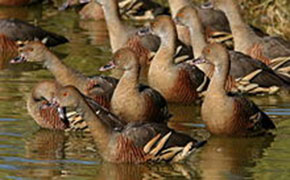
The Plumed Whistling Duck is found in New Guinea and Australia. They prefer to live in tall grassland and savanna, often near bodies of water. The Plumed Whistling Duck is a long-necked duck with brown, chestnut, and white coloring. Their call is a characteristic whistle which gives the bird its name.
The Plumed Whistling Duck feeds on cropping grass on land. Their nesting is a mattress of grasses or similar material in tall grass, or in or near vegetation as cover.
Eclectus Parrot
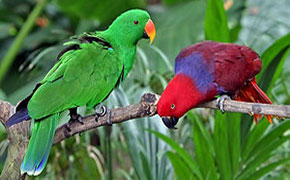
The Eclectus Parrot is native to the Solomon Islands, Sumba, New Guinea, northeastern Australia and the Maluku Islands. The Eclectus' natural habitat is in emergent rain forest trees. The parrot is unusual for its extreme sexual dimorphism of the colors of the plumage; the male has a brilliant emerald green plumage and the female a mostly bright red and purple/blue plumage
The Eclectus Parrot diet consists of mainly fruits, wild figs, unripe nuts, flower and leaf buds, and some seeds. The parrots nests within hollow and large rain forest trees.
Blue Bonnet
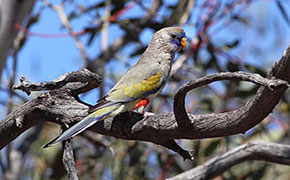
The Blue Bonnet is found in Australia. It lives within the open woodland, scrub, and farmlands in the eastern half of the continent. The Blue Bonnet has a gray chest and a blue forehead and crown with a deep red patch on the abdomen and parts of the thigh.
The Blue Bonnet's main diet consists of native grasses and herbaceous plants, as well as flower and fruit nectar. They nest in low-lying tree openings lined with wood substances.
Open Seven Days a Week
Beerburrum Wildlife Center has something for everyone all year round. At no time during the year is more than 10 percent of the wildlife center closed to the public. We warmly invite you and your family to join us and experience the wonder that the Beerburrum Wildlife Center has to offer.
Weekday Schedule
| Monday | Tuesday | Wednesday | Thursday | Friday | Saturday | Sunday |
|---|---|---|---|---|---|---|
8:00 a.mto8:00 p.m. | 10:00 a.mto8:00 p.m. | 8:00 a.mto8:00 p.m. | 10:00 a.mto8:00 p.m. | 10:00 a.mto8:00 p.m. | 7:00 a.mto10:00 p.m. | 7:00 a.mto10:00 p.m. |
Limited Access Dates
December 20 through December 24 - Island Sector Closed
January 12 through January 20 - Wetland, River, & Lake Sector Closed
February 10 through February 17 - Tundra Sector Closed
March 1 through March 4 - Coastline & Ocean Sector Closed
March 17 through March 21 - Scrubland Sector Closed




































































































